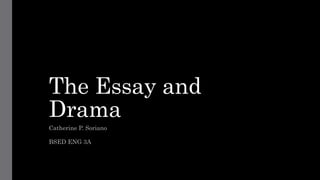
The Essay and Drama.pptx
- 1. The Essay and Drama Catherine P. Soriano BSED ENG 3A
- 2. THE ESSAY
- 3. THE ESSAY • ESSAY is a prose composition of moderate length, usually expository in nature, which aims to explain or clear up an idea, a theory, an impression or point of view. • It may treat any subject from light, humorous, trivial things to the deepest thoughts that the soul can fathom. • There is definite form essays must take. • They may be written to entertain, to inform the mind, or to teach moral or religious truths.
- 4. PARTS OF THE ESSAY
- 6. A. FORMAL OR IMPERSONAL ESSAY -Deals with a serious subject and an important topic like philosophy, science, politics, religion. -Formal, detached, objective, or straightforward -To teach or to inform
- 7. A. INFORMAL OR FAMILLIAR ESSAY -Covers light, ordinary, or even trivial subject matters in a conversational, friendly, and often humorous tone, but equally insightful as that of the formal essay.
- 9. DRAMA
- 10. DRAMA - A story written to be performed by actors. - It may consist of one or more large sections called acts, which are made up of any number of smaller sections called scenes. - Originated in religious rituals and symbolic reenactments of primitive peoples. - The ancient Greeks developed drama into a sophisticated art and created such dramatic forms as comedy and tragedy. - Oedipus the King is a classic example of Greek Tragedy.
- 11. Arena Early Greeks This establishes as intimate relation with the audience.
- 12. Medieval Theatre This used staging areas called mansions inside the churches and portable wagons wheeled about outside the churches.
- 13. Elizabethan Theatre This used a wooden structure providing as enclosed space around a courtyard open to the sky. Actors were in a habit of speaking directly to the audience.
- 14. Proscenium The stage use in the 19th century. This stage distances the audience from the play, providing a clear frame behind which the performers act out their sciences unaware of the audience’s presence.
- 15. Eclectic This is theatre of the modern times. It uses arena, proscenium and every other kind of staging. Some contemporary theatre converts non-theatrical spaces, such as the street, on top of a truck, or a warehouse, into a space for performance.
- 16. Genres of Drama
- 17. A. TRAGEDY • A type of drama that shows the downfall and destruction of a notable or outstanding person, traditionally one who possesses a character weakness called tragic flaw. • The tragic hero, through choice or circumstance, is caught up in a sequence of events that inevitably results in disaster. B. COMEDY • A type of drama that shows the downfall and destruction of a notable or outstanding person, traditionally one who possesses a character weakness called tragic flaw. • The tragic hero, through choice or circumstance, is caught up in a sequence of events that inevitably results in disaster.
- 18. C. TRAGICOMEDY • A play that does not adhere strictly to the structure pf tragedy. This is usually a serious play that also has some of the qualities of comedy. It arouses thought even with laughter. D. FARCE • Has very swift movements. Has ridiculous situations, and does not stimulate thought. Shakespeare's Comedy of the Errors, The Taming of the Shrew and The Merry Wives of Windsor are examples of this. E. MELODRAMA • Show events that follow each other rapidly, but seems to be governed always by chance. The characters are victims in the hands of merciless fate. Shakespeare made use of this in Titus Andronicus and Cymbeline.
- 20. a. Plot - The sequence of events in a drama. Most plots can be analyzed by dividing them into most or all of the following parts: exposition- introduces the setting, the characters, and the basic situation. inciting incident- introduces the central conflict. development-the conflict runs its course and usually intensifies climax- the conflict reaches a high point of interest or suspense resolution-the conflicts is ended. denouement-ties up the loose ends that remain after the resolution of the conflict.
- 21. b. Characters - The entire shape of the action derives from the character’s strengths and weaknesses thus, they create their own opportunities and problems. c. Setting - The time and place in which the action takes place. It also refers to the scenery and physical elements that appear on stage to vivify the author’s stage directions. d. Dialogue - The speeches the characters use to advance the action. Since there is description or commentary on the action, as there is in fiction, the dialogue must tell the whole story. Soliloquy-a speech in which an actor, usually alone on stage, utters his or her thoughts aloud, revealing personal feelings. Aside- a short speech made by a character to the audience which, by convention, the other character on stage do not hear.
- 22. e. Movements - The actor’s movements are keyed to the structure of their speeches. The stage directions give information as to where the characters are, where they go, and even the significance of their movements. f. Music - Song dramas incorporate music for dramatic effect. This may be sung live or used as a background to set the mood of the play. g. Theme - The message, the central action, or what the play is all about. There may be several themes in a play.